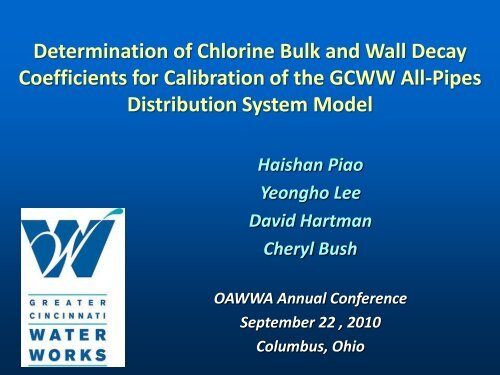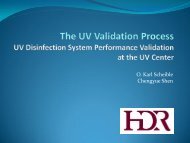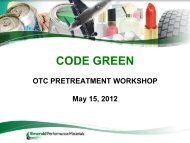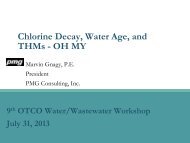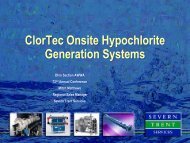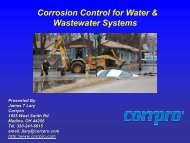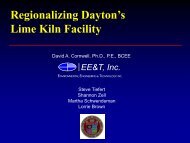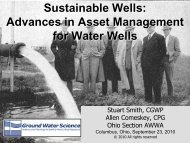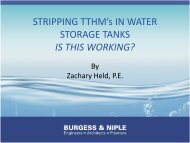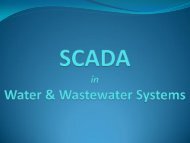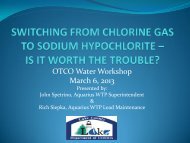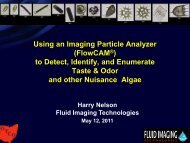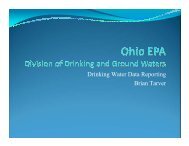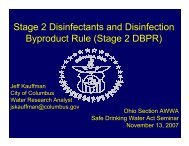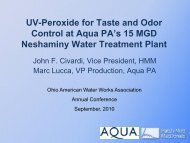Wall Decay Coefficients - Ohiowater.org
Wall Decay Coefficients - Ohiowater.org
Wall Decay Coefficients - Ohiowater.org
You also want an ePaper? Increase the reach of your titles
YUMPU automatically turns print PDFs into web optimized ePapers that Google loves.
Determination of Chlorine Bulk and <strong>Wall</strong> <strong>Decay</strong><br />
<strong>Coefficients</strong> for Calibration of the GCWW All-Pipes<br />
Distribution System Model<br />
Haishan Piao<br />
Yeongho Lee<br />
David Hartman<br />
Cheryl Bush<br />
OAWWA Annual Conference<br />
September 22 , 2010<br />
Columbus, Ohio
Presentation Overview<br />
• GCWW System Overview<br />
• Chlorine Monitoring Field Test<br />
• Chlorine Bulk/<strong>Wall</strong> <strong>Decay</strong> <strong>Coefficients</strong><br />
• Calibration Goals and Results<br />
• Conclusions
Greater Cincinnati Water Works:<br />
System Overview<br />
• 2 Treatment plants:<br />
• Miller: Surface<br />
• Bolton: Ground<br />
• Avg. day pumpage:<br />
140 MGD<br />
• 3100 miles of Water main<br />
• 20 Pumping stations<br />
• 27 Storage tanks<br />
• 11 Pressure zones<br />
• Customers<br />
• Retail<br />
• Wholesale<br />
• Population: 1.1 millions
Distribution System Model:<br />
All Pipes Model<br />
• Built from System-<br />
Wide GIS Data<br />
• Includes all pipes<br />
≥2” in diameter<br />
• Pipes: 200,000<br />
• Hydraulic Calibration<br />
• Chlorine Calibration<br />
• Master Planning,<br />
WQ Analyses, and<br />
Operational<br />
Modeling
Model Calibration Flow Chart<br />
All Pipes Model Construction<br />
Flow/Pressure/Head Loss<br />
Field Testing<br />
Chlorine Monitoring<br />
Hydraulic Calibration<br />
Max Day Calibration<br />
Min Day Calibration<br />
Hydraulic<br />
Verification<br />
Chlorine Calibration<br />
Bulk/<strong>Wall</strong> <strong>Decay</strong><br />
<strong>Coefficients</strong> Options<br />
Chlorine Calibration<br />
Model Scenarios
Friction Coefficient (C-Value)<br />
0<br />
5<br />
10<br />
15<br />
20<br />
25<br />
30<br />
35<br />
40<br />
45<br />
50<br />
55<br />
60<br />
65<br />
70<br />
75<br />
80<br />
85<br />
90<br />
95<br />
100<br />
105<br />
110<br />
115<br />
120<br />
Model Hydraulic Calibration<br />
• Detailed Analysis and Assignment of C Factors<br />
200<br />
190<br />
180<br />
170<br />
160<br />
150<br />
140<br />
130<br />
120<br />
110<br />
100<br />
90<br />
80<br />
70<br />
60<br />
50<br />
40<br />
30<br />
20<br />
All Mains Constructed<br />
Since 1947 (New Mains)<br />
1947 to Present Before 1947<br />
Mains Constructed before<br />
1947 (Old Mains) as shown<br />
> =42"<br />
24" to 36"<br />
12" to 20"<br />
Field Testing to Monitor Chlorine<br />
Residuals<br />
• Conducted during summer and fall of<br />
2007.<br />
• 5 monitoring zones<br />
• 38 temporary<br />
monitors per zone<br />
• Free chlorine<br />
• pH<br />
• Total – 190 locations<br />
• Calibration day for<br />
each zone
Field Testing to Monitor Chlorine<br />
Residuals (cont’d)<br />
• Monitoring Equipments<br />
• Free chlorine and pH:<br />
• ATi Q45H/62<br />
• Data Logger:<br />
• Hobo H08-005-4<br />
Chlorine/pH<br />
Controller<br />
Chlorine<br />
Probe<br />
Pressure<br />
Regulator<br />
pH<br />
Probe
Water Surface Elevation (ft)<br />
Model Hydraulic Verification<br />
685<br />
680<br />
675<br />
670<br />
665<br />
660<br />
655<br />
650<br />
645<br />
640<br />
7/23/07 7/30/07 8/6/07 8/13/07<br />
SCADA Data<br />
Model Data
• Bulk <strong>Decay</strong><br />
• Nature of source water<br />
• Type of water treatment<br />
• <strong>Wall</strong> <strong>Decay</strong><br />
• Pipe material<br />
• Pipe condition<br />
Chlorine <strong>Decay</strong>
Chlorine Bulk <strong>Decay</strong> <strong>Coefficients</strong><br />
• Bulk decay coefficients were developed<br />
based on simulated distribution system<br />
(SDS) test conducted during field testing<br />
program<br />
• Four samples collected for SDS tests at<br />
10-day intervals<br />
• August 9<br />
• August 20<br />
• August 30<br />
• September 10<br />
• 1 st order curves were developed based on<br />
water age and source
Miller Plant First Order Bulk <strong>Decay</strong> Curves<br />
Miller Plant
Bolton Plant First Order Bulk <strong>Decay</strong> Curves<br />
Bolton Plant
Chlorine <strong>Wall</strong> <strong>Decay</strong> <strong>Coefficients</strong><br />
• Approaches to develop wall decay<br />
coefficients:<br />
• Standard global coefficients: Software built-in<br />
“F” curves based on C factor<br />
<strong>Wall</strong> <strong>Decay</strong> Coefficient = F/C<br />
• Multiple curves based on C factor, pipe<br />
diameter, and water source<br />
• Single customized curves based on C factor
<strong>Wall</strong> <strong>Decay</strong> <strong>Coefficients</strong>:<br />
Software Built-in “F” curves
<strong>Wall</strong> <strong>Decay</strong> <strong>Coefficients</strong>:<br />
Multiple Curves Based on C-Factor and Diameters –<br />
<strong>Wall</strong> Option 1 (W1)
<strong>Wall</strong> <strong>Decay</strong> <strong>Coefficients</strong>:<br />
Multiple Curves Based on C-Factor & Source –<br />
W4 & W5
<strong>Wall</strong> <strong>Decay</strong> <strong>Coefficients</strong> :<br />
Single Custom Curve Based on C-Factor –<br />
W2, W3 & W6
<strong>Wall</strong> <strong>Decay</strong> <strong>Coefficients</strong>:<br />
Overview<br />
W1 Lined<br />
W1 Unlined - Small Diam<br />
W1 Unlined - Large Diam<br />
W2 - Single Curve<br />
W3 - Single Curve<br />
W4 - Single Curve - Miller<br />
W4 - Single Curve - Bolton<br />
W5 - Single Curve - Miller<br />
W5 - Single Curve - Bolton<br />
W6 - Single Curve
Model Inputs for Water Quality Runs<br />
• Bulk and wall decay coefficients<br />
• Chlorine concentration at clearwells<br />
• Hydraulic time step – 60 min<br />
• Water quality time step – 2 min<br />
• Simulation time – 21 days
Chlorine Calibration Goals<br />
• Age ↑ - Chlorine↓<br />
• Older water – further out<br />
in the system<br />
• 0-12 hrs → 0.1<br />
• 12-24 hrs → 0.15<br />
• >24 hrs → 0.2
Miller Plant First Order Bulk <strong>Decay</strong> Curves<br />
Miller Plant
Calibration Results:<br />
Bulk <strong>Decay</strong> Options Comparison<br />
Summary of B1 and B2 Results with Comparative <strong>Wall</strong> <strong>Decay</strong> Options<br />
Number of Locations Calibrated<br />
Water Age 0-12 hrs 12 - 24 hrs > 24 hrs<br />
Calibration<br />
Goals 0.1 mg/L 0.15 mg/L 0.2 mg/L<br />
Total<br />
Locations<br />
%<br />
Calibrated<br />
Number of<br />
Locations<br />
3 7 25 35<br />
B1W1 0 4 16 20 57<br />
B1F-7 0 4 22 26 74<br />
B1F-10 0 4 23 27 77<br />
B2W1 1 6 24 31 89<br />
B2F-10 1 6 22 29 83<br />
B2W2 1 6 25 32 91
Calibration Results:<br />
<strong>Wall</strong> <strong>Decay</strong> Options Comparison<br />
• Software Built-in <strong>Wall</strong> <strong>Decay</strong> “F”<br />
Curves<br />
• <strong>Decay</strong> coefficients depend only on<br />
C factor<br />
<strong>Wall</strong> decay Coefficient = F/C<br />
• Less accurate results
<strong>Wall</strong> <strong>Decay</strong> Coeficient, Kw<br />
<strong>Wall</strong> <strong>Decay</strong> <strong>Coefficients</strong>:<br />
0.00<br />
<strong>Wall</strong> <strong>Decay</strong> <strong>Coefficients</strong><br />
Hazen Williams C Value<br />
0 20 40 60 80 100 120 140<br />
-0.05<br />
-0.10<br />
-0.15<br />
-0.20<br />
-0.25<br />
-0.30<br />
W1 Lined<br />
W1 Unlined - Small Diam<br />
W1 Unlined - Large Diam<br />
W2 - Single Curve<br />
W3 - Single Curve<br />
W4 - Single Curve - Miller<br />
W4 - Single Curve - Bolton<br />
W5 - Single Curve - Miller<br />
W5 - Single Curve - Bolton<br />
W6 - Single Curve<br />
-0.35
Calibration Results:<br />
<strong>Wall</strong> <strong>Decay</strong> Comparison (cont’d)<br />
170 Points of Calibration<br />
(After Eliminating Bad and Questionable Data)<br />
Number of Locations Calibrated<br />
Water Age < 12 hrs 12 - 24 hrs > 24 hrs<br />
Calibration<br />
Goals<br />
Number of<br />
Locations<br />
0.1 mg/L 0.15 mg/L 0.2 mg/L<br />
Total<br />
Locations<br />
25 29 116 170<br />
%<br />
Calibrated<br />
B2W1 13 24 106 143 84.1<br />
B2W2 14 24 106 144 84.7<br />
B2W3 13 25 109 147 86.5<br />
B2W4 14 24 108 146 85.9<br />
B2W5 14 25 108 147 86.5<br />
B2W6 14 25 107 146 85.9
Calibration Results:<br />
<strong>Wall</strong> <strong>Decay</strong> Comparison (cont’d)<br />
Test<br />
Zone<br />
Modeled Concentration vs. Observed Concentration (170 Points of Calibration)<br />
Option<br />
B2W1<br />
Deviation in Chlorine Concentration (mg/L)<br />
Option<br />
B2W2<br />
Option<br />
B2W3<br />
Option<br />
B2W4<br />
Option<br />
B2W5<br />
Option<br />
B2W6<br />
Zone 1 0.116 0.103 0.113 0.121 0.113 0.109<br />
Zone 2 0.098 0.137 0.102 0.094 0.102 0.110<br />
Zone 3 0.125 0.095 0.115 0.117 0.111 0.109<br />
Zone 4 0.059 0.054 0.053 0.057 0.053 0.052<br />
Zone 5 0.110 0.086 0.096 0.088 0.090 0.093<br />
System 0.102 0.095 0.096 0.095 0.094 0.095
Conclusions<br />
• Field testing data were used for chlorine<br />
calibration of GCWW all pipes distribution<br />
system model.<br />
• Chlorine Bulk <strong>Decay</strong> <strong>Coefficients</strong>:<br />
• Bulk decay coefficients can be variable.<br />
Especially for Miller water.<br />
• Higher decay rate for younger water than older<br />
water.<br />
• Multiple 1 st order decay curves had to be<br />
developed based on water age for each water<br />
source to obtain the best results.
Conclusions (cont’d)<br />
• Chlorine <strong>Wall</strong> <strong>Decay</strong> <strong>Coefficients</strong><br />
• Aggressive decay for older pipes compared to<br />
younger pipes.<br />
• Software Built-in “F” curves did not yield<br />
desirable results.<br />
• Highest degree of calibration achieved by using<br />
curve based on pipe roughness, pipe diameter,<br />
and water source.<br />
• <strong>Wall</strong> decay coefficients simplified by a single<br />
custom curve based on C-factor without<br />
sacrificing calibration accuracy.
Acknowledgement<br />
• Black & Veatch<br />
• Eva Sinha, P.E.<br />
• Jeff Stillman, P.E.<br />
• Marissa Albright, P.E.<br />
• Kevin Laptos, P.E.<br />
• Larry Gaddis, P.E.<br />
• ID Modeling<br />
• Jerry Edwards, P.E.
Questions???<br />
Haishan.Piao@<br />
GCWW.Cincinnati-Oh.gov


